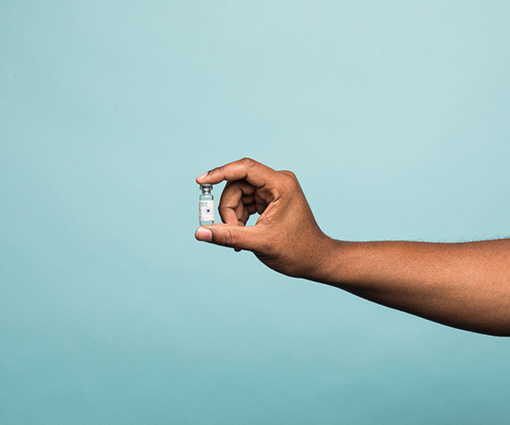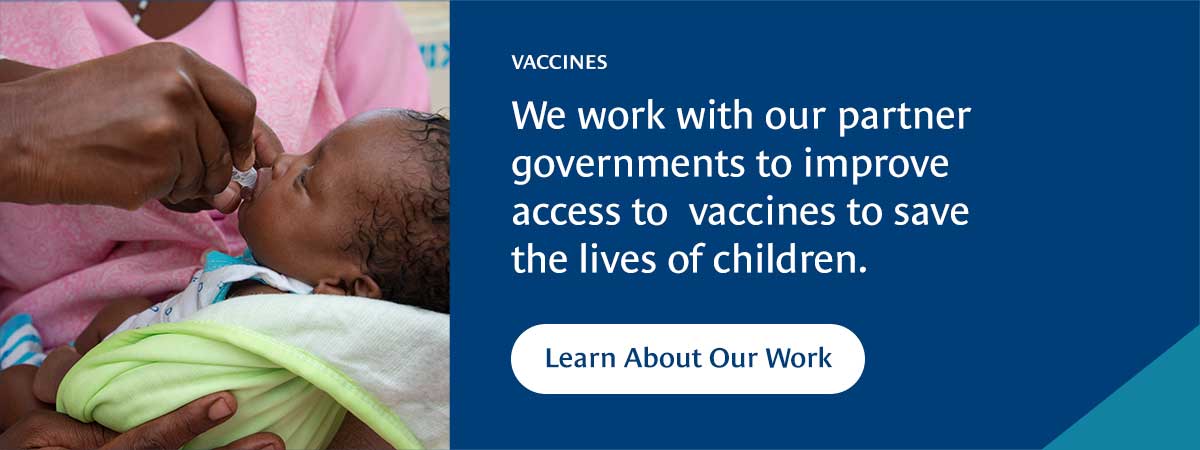Results from a joint assessment by Africa CDC, CHAI, and PATH
Africa is largely reliant on other regions of the world for lifesaving vaccines. Only one percent of the vaccines administered in Africa are produced locally; the remaining 99 percent are imported.[1] Such an imbalance in production can contribute to unequal access to life-saving vaccines and enormous health disparities between regions.
The COVID-19 pandemic further highlighted issues of inequity, with Africa last in line to receive COVID-19 vaccines and trailing far behind other parts of the world in terms of vaccination rates. It also led to a surge in local political support for vaccine production.
As a result, African vaccine manufacturing is set to expand dramatically. But, with so many new projects on the horizon, a clear picture of gaps and needs is necessary to ensure all stakeholders are aligned and investments lead to impact.
Together, the Africa Centres for Disease Control and Prevention (Africa CDC), the Clinton Health Access Initiative (CHAI), and PATH have mapped the current and planned vaccine manufacturing capacity in Africa to generate insights into what is needed to develop a robust and sustainable vaccine manufacturing ecosystem. This information can help stakeholders, governments, and funders better coordinate and prioritize development efforts, interventions, and investments.
Study methodology
Between December 2022 and March 2023, a collaborative team with representatives from Africa CDC, CHAI, and PATH engaged vaccine manufacturers across Africa on their current and planned production capacity, technical and commercial capabilities, and supporting functions (such as regulatory and finance).
We engaged 19 manufacturers in total, including all manufacturers with commercial scale production capacity as well as a number of early-stage projects. We also engaged with a variety of originator companies outside of Africa interested in technology transfers to African vaccine manufacturers to understand where they see opportunities, challenges, and considerations for collaboration.
When possible, we calculated capacity estimates in a range from minimum to maximum, due to manufacturer uncertainty about antigens and number of doses per container. Actual annual capacity may vary significantly.
We used the year 2030 as a benchmark for vaccine demand.
We also reference the year 2040 to reflect the Partnerships for African Vaccine Manufacturing (PAVM) Framework for Action, which sets the goal of manufacturing 60 percent of Africa’s routine immunization needs on the continent by 2040.[2]
Caveats
Other aspects of the vaccine manufacturing ecosystem that are critical success factors were not covered by this research, including infrastructure development and improvement, national regulatory authority strengthening, and market shaping, among others.
Findings
An excess of form/fill/finish, a dearth of antigen production
The current and planned vaccine manufacturing capacity is distributed across numerous manufacturers in all regions of Africa. This analysis looked across the two critical steps needed in the vaccine manufacturing process:
- Drug substance production: Producing the active vaccine component (or, antigen), which is the most cost-intensive and technically challenging step; and
- Drug product production: Producing the final vaccine product, which includes formulation, fill, and finish (form/fill/finish).
Africa’s current capacity (including ordered capacity) to form/fill/finish vaccines by relying on imported antigen is around 2 billion doses. This far exceeds the current average annual vaccine demand of 1.3 billion doses. Moreover, additional capacity to form/fill/finish vaccines is planned and would increase production by 2 billion-plus doses. If all plans are realized, capacity to form/fill/finish vaccines would more than double the projected African vaccine demand in 2030.
While some of this capacity may be used for non-vaccine products, the scale of overcapacity means there is a risk not every manufacturing project will be sustainable. Though individual manufacturers may have valid reasons for increasing their form/fill/finish capacity, across the industry, the result will be significant excess capacity that can create challenges for commercial viability.
Conversely, the existing capacity in Africa to produce antigens locally is very limited and well below the capacity that would be needed to meet PAVM’s domestic production targets. Additionally, a large portion of that capacity is currently being used for non-vaccine products. Plans to expand manufacturing from antigen production through to final product are in development, but even these are not enough to close the gap between production and demand.
Limited access to technology transfer
Africa is reliant on technology transfers with non-African vaccine manufacturers to access the bulk supply of a given antigen and produce the final vaccine product. This reliance is due to the complex nature of vaccine manufacturing and the urgency with which manufacturers needed to scale production on the continent.
But, at present, there are limited technology transfers for the majority of the total current and planned form/fill/finish capacity—which means that African vaccine manufacturers will only be able to produce a fraction of what they theoretically could.
Notably, technology transfer can be an important step in developing capacity to produce antigens locally and can set the stage for later backward integration of the antigen manufacturing process, for manufacturers that choose to expand in that direction.
Uncertain demand commitments from governments for African-made vaccines further complicate manufacturers’ abilities to secure technology transfer agreements. The build-up of vaccine manufacturing capacity in other regions (e.g., India or China) has historically been supported through government-backed demand commitments. Demand uncertainty creates a barrier for African vaccine manufacturers working to partner with originator companies. Even among those manufacturers that have been able to sign agreements, unclear demand is delaying implementation of the transfers.
Further, a single vaccine manufacturer is the source for most current technology transfers to Africa, which creates a significant dependence that makes the continent’s manufacturing ecosystem vulnerable to any disruptions or issues that may arise with this manufacturer.
Available capacity does not equal commercial success
African vaccine manufacturers have the potential for significant manufacturing capacity, but commercial success is not guaranteed.
With so many new projects on the horizon, a clear picture of gaps and needs is necessary to ensure all stakeholders are aligned and investments lead to impact.
While many manufacturers already have strong financial capabilities (the means to access financing for the facilities and operations needed to produce vaccines) further commercial capabilities must be developed; for example, establishing a strategic business plan to market those vaccines. Success depends on commercial savvy, market access, and effective partnerships, among other important factors.
However, the biggest obstacles to building sustainable vaccine manufacturing capacity are market access and demand materialization. While most African vaccine manufacturers have strong connections to local governments and markets, they face challenges breaking into the regional and global markets that are necessary for long-term success. Local government support has been a driving force behind many manufacturers’ plans, but it has also led to strategies that are aligned to local political decisions rather than global market requirements.
In particular, accessing the substantial Gavi market will require manufacturers to achieve World Health Organization prequalification—which requires additional development time and significant investments to achieve international manufacturing quality standards.
Recommendations
Investor and donor support is crucial to a healthy and sustainable vaccine manufacturing ecosystem in Africa, but careful consideration should be given to how a particular investment fits into the whole and whether it will ultimately help market health and Africa’s pandemic preparedness.
Likewise, African vaccine manufacturers, local governments, and other stakeholders in Africa should focus on efforts that build the continental vaccine manufacturing ecosystem, like regulatory strengthening and workforce development, rather than efforts that only benefit a particular manufacturer or country.
For investors and donors
Africa’s capacity to form/fill/finish vaccines already more than satisfies the continent’s current and future vaccine needs—a capacity that could grow even larger as more and more manufacturers strengthen their vaccine manufacturing programs. Further investment in form/fill/finish capacity building should be reconsidered in favor of efforts that strengthen commercial viability.
Because antigen manufacturing capabilities lag so far behind form/fill/finish ones in both quality and capacity, investments that build capacity to manufacture antigens locally—such as facility building, technology transfer, or technical assistance—can strengthen end-to-end vaccine manufacturing capabilities.
To significantly improve the speed and likelihood of manufacturers entering the market with products that meet international quality standards, donors should fund technical support to achieve international standards for Good Manufacturing Practice, and to prepare for and secure World Health Organization prequalification, among other capabilities.
For African vaccine manufacturers and African governments
African vaccine manufacturers can improve the likelihood that investments have the intended impact on health and pandemic preparedness by strengthening their commercial strategies and business planning and determining a clear pathway to market access.
Additionally, given the current reliance on a single non-African vaccine manufacturer for technology transfers, diversifying technology transfer partners will mitigate the risk of a market monopoly for antigen production.
More precise demand commitments from African governments for African-made vaccines are fundamental to catalyze technology transfers and create a market for these products—a key requirement for manufacturers to build a long-term sustainable vaccine business.
Next steps
Increasing Africa’s vaccine manufacturing capacity will be a multi-year, complex undertaking that will require stakeholders across the public, private, and social sectors to work together to create a robust enabling environment. Examining current and planned vaccine manufacturing capacity is only one step on the path toward sustainability. In support of continued progress, work is ongoing across all partners.
PATH is working with partners to determine the conditions needed to achieve the planned capacity, referred to as “future state mapping.” These conditions include:
- Number, size, and characteristics of production lines and manufacturing plants;
- Workforce numbers and types of expertise;
- Estimated number of batches that need to be produced per year; and
- Critical supply chain or raw materials and components needed for manufacturing
CHAI is working with key stakeholders to develop a set of high-impact market-shaping interventions and support in their execution. This includes addressing the strategic and commercial gaps identified through the landscaping exercise, such as:
- Facilitating strategic technology transfers and supporting the development of commercial strategies for high-potential manufacturers;
- Ensuring financial incentives are tailored toward a sustainable African vaccine manufacturing ecosystem; and
- Supporting demand commitments that contribute to a sustainable African vaccine manufacturing ecosystem.
Africa CDC is working with African Union Member States to agenda-set activities guided by the PAVM Framework for Action by developing initiatives to support the procurement of African-made vaccines. Some activities include:
- Preparing national regulatory authorities to regulate manufacturing for the planned vaccines; and
- Providing hands-on training in areas like biomanufacturing and Good Manufacturing Practice, to equip the manufacturing workforce with essential skills and knowledge.
References
[1] “Scaling up African vaccine manufacturing capacity.” Wellcome, January 2023. Wellcome-Biovac-BCG-Scaling-up-African-vaccine-manufacturing-capacity-report-2023_0.pdf.
[2] “Partnerships for African Vaccine Manufacturing (PAVM) Framework for Action.” PAVM. March 2022. https://africacdc.org/download/partnerships-for-african-vaccine-manufacturing-pavm-framework-for-action/.
This work was made possible by the support of the American people through the United States Agency for International Development (USAID) and by funding from the Bill & Melinda Gates Foundation. The contents do not necessarily reflect the views of USAID or the United States Government, or the Bill & Melinda Gates Foundation.







